Research on Optimal Configuration of Landscape Storage in Public Buildings Based on Improved NSGA-II
Abstract
1. Introduction
- Taking an existing public building as an example, a renewable energy microgrid structure based on wind power and photovoltaic power generation combined with an energy storage system is constructed;
- Establishing a multi-objective renewable energy capacity allocation and optimization model for public buildings considering cost objectives, carbon emission reduction objectives and grid-connected security objectives;
- Proposing a spatial transformation constraint processing method to transform the unsatisfied solution into a feasible solution in a feasible domain. The spatial transformation method combined with the NSGA-II is applied to the problem that the number of feasible solutions is reduced due to multi-variable mutual constraints and the problem that the strong constraints are difficult to meet.
- Using the STNSGA-II proposed in this paper to simulate and solve the multi-objective renewable energy optimization model of public buildings to verify its effectiveness.
2. Power Supply Model
2.1. Microgrid Structure of Public Buildings
2.2. Wind Power Generation System Model
2.2.1. Fan Generation Model
2.2.2. Calibration of Wind Speed at Fan Hub Height
2.3. Photovoltaic Power Generation Model
2.4. Battery Energy Storage Model
2.5. Grid-Connected Inverter Power Model
3. Optimal Allocation Model of Public Building
3.1. Average Daily Processing Model
3.2. Economic Objectives of Microgrid Systems
3.2.1. Equipment Acquisition Cost
3.2.2. Equipment Operation and Maintenance Costs
3.2.3. Electricity Transaction Cost of Microgrid System
3.3. Microgrid System Grid-Connected Security Objective
3.4. Environmental Protection Objective of Public Building Microgrid System
4. Constraint Condition
4.1. Power Balance Constraint
4.2. Constraint of Active Power Shortage of New Energy Power Generation System
4.3. Restriction on the Number of Installed PV Arrays
4.4. Fan Installation Quantity Constraint
4.5. Wind and Photovoltaic Complementary Power Generation Constraints
4.6. Battery Constraints
5. Methods
5.1. Outline of NSGA-II
- The fast non-dominated sorting method reduces the computational complexity of non-dominated sorting;
- Elite strategy is introduced to expand the sampling space and improve the accuracy of the optimization results;
- The introduction of crowding comparison operators overcome the defect that shared parameters need to be specified in the NSGA, and the crowding comparison operators are used as the comparison criteria between individuals of the population.
- The individuals of the population are evenly distributed in the whole Pareto frontier to ensure the diversity of the population. The NSGA-II is described in detail in reference [41].
5.2. Application and Defect of NSGA-II
5.3. The Improvement of NSGA-II
- The transformation logic of the equality constraint :
- The transformation logic of inequality constraints
5.4. STNSGA-II Algorithm Flow
6. Case Studies and Simulation Results
6.1. Simulation Case and Initial Data Processing
6.1.1. Simulation Case
6.1.2. Fan Data Processing
6.1.3. Photovoltaic Arrays Data Processing
6.1.4. Building Electricity Load
6.1.5. Datas Averaging Processing
6.2. Simulation Results of Multi-Objective Optimization and Analysis
6.2.1. Simulation Results
6.2.2. Economic Analysis
6.2.3. Analysis of Grid-Connected Security
6.2.4. Carbon Reduction Analysis
6.2.5. Comparative Analysis of Algorithms
6.2.6. The Future Research
7. Conclusions
- The application of a renewable power generation system in public buildings has a practical significance. The use of clean and renewable energy can not only increase the diversity of energy and reduce the use of fossil energy, but it can also produce certain economic benefits and reduce the cost of daily energy use;
- The energy storage system absorbs the energy produced by the renewable power generation system, and, at the same time, participates in the peak cutting and valley filling of the whole operation cycle. It converts the fluctuation of the wind power and photovoltaic grid-connected energy into the charging and discharging process of the battery, which plays an important role in the protection of the power grid;
- In this study, aiming at the drawbacks of the traditional NSGA-II, with which it is difficult to solve multi-objective strong constraint problems, a spatial transformation constraint processing concept is proposed to deal with strong constraints. Results show that the STNSGA-II has more advantages than the NSGA-II in solving constrained nonlinear multi-objective optimization problems.
Author Contributions
Funding
Institutional Review Board Statement
Informed Consent Statement
Data Availability Statement
Conflicts of Interest
Nomenclature
| Symbol | Meaning |
| afan | The wind speed correction coefficient |
| C | The total cost of the microgrid system of public buildings |
| Cbat(t) | The energy storage capacity of the battery at time t |
| Cbat(t − 1) | The energy storage capacity of the battery at time t − 1 |
| Cbat,max | The maximum capacity of the battery |
| Cbat,min | The minimum capacity of the battery |
| Cc | The cost of equipment acquisition in the microgrid |
| CE(t) | The electricity price at time t |
| Cgird | Transaction profit and loss cost generated by energy exchange between the microgrid and power grid |
| Ci | The purchase cost of each piece of equipment |
| Co&m | The operation and maintenance cost of the equipment |
| Co&m-wind | The operation and maintenance cost of the fans in a working cycle |
| Co&m-pv | The operation and maintenance cost of the photovoltaic array in a working cycle |
| Co&m-bat | The operation and maintenance cost of the battery in a working cycle |
| Co&m-grid | The operation and maintenance cost of the inverter in a working period |
| Cp | The wind energy utilization coefficient |
| Capgrid | The capacity of the grid-connected inverter |
| Dfan | The diameter of the fan blade |
| Dpv-pv | The distance between adjacent PV arrays |
| Droof | The width of the roof |
| dpv | The width of the photovoltaic panels |
| f | The PV array power derating factor |
| Gen | The number of iterations |
| Gp | The actual solar irradiance on the surface of the PV array |
| Gstc | The solar radiation of the PV array under standard test conditions |
| h0 | The unified observation height of the wind speed |
| hfan | The vertical height of the fan from the horizontal plane |
| his | The overall height of the fan |
| j | The service life of the equipment |
| k | The number of days of equipment life |
| Kmax | The maximum value of the ratio between wind power and photoelectric power |
| Kmin | The minimum value of the ratio between wind power and photoelectric power |
| Lpv | The length of the photovoltaic array |
| Lroof | The length of the roof |
| Mco2 | The carbon dioxide emission reduction index |
| mgrid-co2 | The carbon emission of coal power generation |
| mpv-co2 | The carbon emission of photovoltaic power generation |
| mwind-co2 | The carbon emission of fan power generation |
| Nfan | The actual installed number of fans |
| Nfan,max | The maximum installed number of fans |
| Ni | The installed number of pieces of equipment, respectively, the number of fans, photovoltaic panels |
| Npv | The actual number of photovoltaic arrays installed |
| Npv,max | The maximum number of photovoltaic panels installed |
| NSGA-II | Non-dominated Sorting Genetic Algorithm-II |
| Pbat(t) | The electric energy actually released by the energy storage system at time t |
| Pbat,max | The maximum allowable charging and discharging power of the battery |
| pc | The crossover probability |
| Pfm | The maximum output power of the fan |
| Pfr | The rated output power of the fan |
| Pgrid(t) | The electric energy exchanged between the microgrid and the power grid at time t |
| The average electric energy exchange value between the inverter and the external grid within an optimization cycle | |
| pm | The mutation probability |
| PV | Photovoltaic |
| Ppv | The output power of the PV |
| Ppv,stc | The rated capacity of the PV array |
| Pwind | The output power of the fan |
| r | The inflation rate |
| S | The actual scavenging area of the fan blade |
| Sfan | The floor area of the fan installation |
| sizepop | The population number |
| SOC | The state of charge |
| SOCbat,max | The maximum charge state of the battery |
| SOCbat,min | The minimum charge state of the battery |
| Spv | The area occupied by a single photovoltaic array considering the distance between photovoltaic arrays |
| STNSGA-II | Spatial Transformation Non-dominated Sorting Genetic Algorithm-II |
| Tpv,p | The actual temperature of the PV array surface |
| Tpv,stc | The temperature under standard test conditions |
| v | The actual wind speed |
| Vci | The cut-in wind speed |
| Vco | The cut-off wind speed |
| Vh0 | The measured wind speed at h0 |
| Vm | The maximum wind speed |
| Vr | The rated wind speed |
| α | The angle between the photovoltaic array and the horizontal plane |
| αpv | The power temperature coefficient |
| δ | The self-discharge rate of the battery |
| δgrid | The grid-connected inverter fluctuation index |
| δloss | The active power deficiency rate |
| δloss,max | The maximum active power deficiency rate of the new energy power generation system |
| ηc | The charging efficiencies of the battery |
| ηd | The discharging efficiencies of the battery |
| ρ | The air density at the height of the fan hub |
| φ | The latitude of photovoltaic placement area |
| The downward integral function |
References
- Sharma, S.; Verma, A.; Xu, Y.; Panigrahi, B.K. Robustly Coordinated Bi-Level Energy Management of a Multi-Energy Building Under Multiple Uncertainties. IEEE Trans. Sustain. Energy 2021, 12, 3–13. [Google Scholar] [CrossRef]
- Al-Refaie, A.; Lepkova, N. Impacts of Renewable Energy Policies on CO2 Emissions Reduction and Energy Security Using System Dynamics: The Case of Small-Scale Sector in Jordan. Sustainability 2022, 14, 5058. [Google Scholar] [CrossRef]
- Navaratnam, S.; Ngo, T.; Gunawardena, T.; Henderson, D. Performance Review of Prefabricated Building Systems and Future Research in Australia. Buildings 2019, 9, 38. [Google Scholar] [CrossRef]
- González, J.; Soares, C.A.P.; Najjar, M.; Haddad, A.N. BIM and BEM Methodologies Integration in Energy-Efficient Buildings Using Experimental Design. Buildings 2021, 11, 491. [Google Scholar] [CrossRef]
- Das, S.S.; Das, A.; Dawn, S.; Gope, S.; Ustun, T.S. A Joint Scheduling Strategy for Wind and Solar Photovoltaic Systems to Grasp Imbalance Cost in Competitive Market. Sustainability 2022, 14, 5005. [Google Scholar] [CrossRef]
- Lee, Y.H.; Jeong, I.W.; Sung, T.H. An Assessment of the Optimal Capacity and an Economic Evaluation of a Sustainable Photovoltaic Energy System in Korea. Sustainability 2021, 13, 12264. [Google Scholar] [CrossRef]
- Chen, Y.; Chen, Z.; Yuan, X.; Su, L.; Li, K. Optimal Control Strategies for Demand Response in Buildings under Penetration of Renewable Energy. Buildings 2022, 12, 371. [Google Scholar] [CrossRef]
- AlKassem, A.; Draou, A.; Alamri, A.; Alharbi, H. Design Analysis of an Optimal Microgrid System for the Integration of Renewable Energy Sources at a University Campus. Sustainability 2022, 14, 4175. [Google Scholar] [CrossRef]
- Szypowski, M.; Siewierski, T.; Wędzik, A. Optimization of Energy-Supply Structure in Residential Premises Using Mixed-Integer Linear Programming. IEEE Trans. Ind. Electron. 2019, 66, 1368–1378. [Google Scholar] [CrossRef]
- Qi, J.; Liu, L.; Shen, Z.; Xu, B.; Leung, K.; Sun, Y. Low-Carbon Community Adaptive Energy Management Optimization Toward Smart Services. IEEE Trans. Ind. Inform. 2020, 16, 3587–3596. [Google Scholar] [CrossRef]
- Wang, B.; Xie, X.; Ding, W.; Yang, D.; Ying, L.; Zhu, G. Optimization of Retail Packages Adapted to the Electricity Spot Market with the Goal of Carbon Peak and Carbon Neutrality. In Proceedings of the 2021 IEEE 4th International Conference on Renewable Energy and Power Engineering (REPE), Beijing, China, 9–11 October 2021; pp. 311–317. [Google Scholar] [CrossRef]
- Qi, J.; Lai, C.; Xu, B.; Sun, Y.; Leung, K.-S. Collaborative Energy Management Optimization Toward a Green Energy Local Area Network. IEEE Trans. Ind. Inform. 2018, 14, 5410–5418. [Google Scholar] [CrossRef]
- Cui, S.; Wang, Y.; Xiao, J. Peer-to-Peer Energy Sharing Among Smart Energy Buildings by Distributed Transaction. IEEE Trans. Smart Grid 2019, 10, 6491–6501. [Google Scholar] [CrossRef]
- Razmara, M.; Bharati, G.R.; Shahbakhti, M.; Paudyal, S.; Robinett, R.D. Bilevel Optimization Framework for Smart Building-to-Grid Systems. IEEE Trans. Smart Grid 2018, 9, 582–593. [Google Scholar] [CrossRef]
- Thirugnanam, K.; El Moursi, M.S.; Khadkikar, V.; Zeineldin, H.H.; Hosani, M.A. Energy Management Strategy of a Reconfigurable Grid-Tied Hybrid AC/DC Microgrid for Commercial Building Applications. IEEE Trans. Smart Grid 2022, 13, 1720–1738. [Google Scholar] [CrossRef]
- Aaslid, P.; Korpas, M.; Belsnes, M.M.; Fosso, O. Stochastic Optimization of Microgrid Operation with Renewable Generation and Energy Storages. IEEE Trans. Sustain. Energy 2022, 13, 1481–1491. [Google Scholar] [CrossRef]
- Oskouei, M.Z.; Mohammadi-Ivatloo, B.; Erdinç, O.; Erdinç, F.G. Optimal Allocation of Renewable Sources and Energy Storage Systems in Partitioned Power Networks to Create Supply-Sufficient Areas. IEEE Trans. Sustain. Energy 2021, 12, 999–1008. [Google Scholar] [CrossRef]
- Wu, X.; Tang, Z.; Stroe, D.-I.; Kerekes, T. Overview and Comparative Study of Energy Management Strategies for Residential PV Systems with Battery Storage. Batteries 2022, 8, 279. [Google Scholar] [CrossRef]
- Antoniadou-Plytaria, K.; Steen, D.; Tuan, L.A.; Carlson, O.; Ghazvini, M.A.F. Market-Based Energy Management Model of a Building Microgrid Considering Battery Degradation. IEEE Trans. Smart Grid 2021, 12, 1794–1804. [Google Scholar] [CrossRef]
- Ruiz-Cortes, M.; Gonzalez-Romera, E.; Amaral-Lopes, R.; Romero-Cadaval, E.; Martins, J.; Milanes-Montero, M.I.; Barrero-Gonzalez, F. Optimal Charge/Discharge Scheduling of Batteries in Microgrids of Prosumers. IEEE Trans. Energy Convers. 2019, 34, 468–477. [Google Scholar] [CrossRef]
- Vašak, M.; Kujundžić, G. A Battery Management System for Efficient Adherence to Energy Exchange Commands Under Longevity Constraints. IEEE Trans. Ind. Appl. 2018, 54, 3019–3033. [Google Scholar] [CrossRef]
- Taylor, Z.; Akhavan-Hejazi, H.; Cortez, E.; Alvarez, L.; Ula, S.; Barth, M.; Mohsenian-Rad, H. Customer-Side SCADA-Assisted Large Battery Operation Optimization for Distribution Feeder Peak Load Shaving. IEEE Trans. Smart Grid 2019, 10, 992–1004. [Google Scholar] [CrossRef]
- Vedullapalli, D.T.; Hadidi, R.; Schroeder, B. Combined HVAC and Battery Scheduling for Demand Response in a Buildin. IEEE Trans. Ind. Appl. 2019, 55, 7008–7014. [Google Scholar] [CrossRef]
- Ahmad, A.; Khan, J.Y. Roof-Top Stand-Alone PV Micro-Grid: A Joint Real-Time BES Management, Load Scheduling and Energy Procurement from a Peaker Generator. IEEE Trans. Smart Grid 2019, 10, 3895–3909. [Google Scholar] [CrossRef]
- Hao, H.; Wu, D.; Lian, J.; Yang, T. Optimal Coordination of Building Loads and Energy Storage for Power Grid and End User Services. IEEE Trans. Smart Grid 2018, 9, 4335–4345. [Google Scholar] [CrossRef]
- Zhang, G.; Tian, Z.; Tricoli, P.; Hillmansen, S.; Wang, Y.; Liu, Z. Inverter Operating Characteristics Optimization for DC Traction Power Supply Systems. IEEE Trans. Veh. Technol. 2019, 68, 3400–3410. [Google Scholar] [CrossRef]
- Wang, Q.; Li, Y.; Ma, Y.; Chen, X. Research on multi-objective optimization design technology of regional integrated energy system. In Proceedings of the 16th IET International Conference on AC and DC Power Transmission (ACDC 2020), Online, 2–3 July 2020; pp. 1683–1688. [Google Scholar] [CrossRef]
- Wang, F.; Zhou, L.; Ren, H.; Liu, X.; Shafie-khah, M.; Catalão, J.P.S. Multi-Objective Optimization Model of Source–Load–Storage Synergetic Dispatch for a Building Energy Management System Based on TOU Price Demand Response. IEEE Trans. Ind. Appl. 2018, 54, 1017–1028. [Google Scholar] [CrossRef]
- Fleischhacker, A.; Auer, H.; Lettner, G.; Botterud, A. Sharing Solar PV and Energy Storage in Apartment Buildings: Resource Allocation and Pricing. IEEE Trans. Smart Grid 2019, 10, 3963–3973. [Google Scholar] [CrossRef]
- Wang, Y.; Wang, Y.; Huang, Y.; Yu, H.; Du, R.; Zhang, F.; Zhang, F.; Zhu, J. Optimal Scheduling of the Regional Integrated Energy System Considering Economy and Environment. IEEE Trans. Sustain. Energy 2019, 10, 1939–1949. [Google Scholar] [CrossRef]
- Mei, R.; Wu, T.; Geng, D.; Zhang, M.; Liu, Y.; Qian, X.; Sun, Y. Multi-objective optimization of integrated energy system based on improved NSGA-II algorithm. In Proceedings of the 2020 39th Chinese Control Conference (CCC), Shenyang, China, 27–29 July 2020; pp. 1721–1726. [Google Scholar] [CrossRef]
- Yang, Y.; Wu, W.; Wang, B.; Li, M. Chance-Constrained Economic Dispatch Considering Curtailment Strategy of Renewable Energy. IEEE Trans. Power Syst. 2021, 36, 5792–5802. [Google Scholar] [CrossRef]
- Garifi, K.; Baker, D.; Christensen, D.; Touri, B. Convex Relaxation of Grid-Connected Energy Storage System Models With Complementarity Constraints in DC OPF. IEEE Trans. Smart Grid 2020, 11, 4070–4079. [Google Scholar] [CrossRef]
- Ming, M.; Wang, R.; Ishibuchi, H.; Zhang, T. A Novel Dual-Stage Dual-Population Evolutionary Algorithm for Constrained Multi-Objective Optimization. IEEE Trans. Evol. Comput. 2021, 26, 1129–1143. [Google Scholar] [CrossRef]
- Lee, S.; Kwon, B.; Lee, S. Joint Energy Management System of Electric Supply and Demand in Houses and Buildings. IEEE Trans. Power Syst. 2014, 29, 2804–2812. [Google Scholar] [CrossRef]
- Abdul Majid, A. Forecasting Monthly Wind Energy Using an Alternative Machine Training Method with Curve Fitting and Temporal Error Extraction Algorithm. Energies 2022, 15, 8596. [Google Scholar] [CrossRef]
- Li, J.; Zhao, H. Multi-Objective Optimization and Performance Assessments of an Integrated Energy System Based on Fuel, Wind and Solar Energies. Entropy 2021, 23, 431. [Google Scholar] [CrossRef] [PubMed]
- Toma, P.; Dorin, P.; Radu, E.; Daniel, M. Sizing photovoltaic-wind smart microgrid with battery storage and grid connection. In Proceedings of the 2014 IEEE International Conference on Automation, Quality and Testing, Robotics, Cluj-Napoca, Romania, 22–24 May 2014; pp. 1–5. [Google Scholar] [CrossRef]
- Ren, F.; Wang, J.; Zhu, S.; Chen, Y. Multi-objective optimization of combined cooling, heating and power system integrated with solar and geothermal energies. Energy Convers. Manag. 2019, 197, 111866. [Google Scholar] [CrossRef]
- Faisal, M.; Hannan, M.A.; Ker, P.J.; Lipu, M.S.H.; Uddin, M.N. Fuzzy-Based Charging–Discharging Controller for Lithium-Ion Battery in Microgrid Applications. IEEE Trans. Ind. Appl. 2021, 57, 4187–4195. [Google Scholar] [CrossRef]
- Deb, K.; Pratap, A.; Agarwal, S.; Meyarivan, T. A fast and elitist multiobjective genetic algorithm: NSGA-II. IEEE Trans. Evol. Comput. 2002, 6, 182–197. [Google Scholar] [CrossRef]
- Deb, K.; Jain, H. An Evolutionary Many-Objective Optimization Algorithm Using Reference-Point-Based Nondominated Sorting Approach, Part I: Solving Problems with Box Constraints. IEEE Trans. Evol. Comput. 2014, 18, 577–601. [Google Scholar] [CrossRef]
- Jain, H.; Deb, K. An Evolutionary Many-Objective Optimization Algorithm Using Reference-Point Based Nondominated Sorting Approach, Part II: Handling Constraints and Extending to an Adaptive Approach. IEEE Trans. Evol. Comput. 2014, 18, 602–622. [Google Scholar] [CrossRef]
- Li, F.; Li, X.; Zhang, B.; Li, Z.; Lu, M. Multiobjective Optimization Configuration of a Prosumer’s Energy Storage System Based on an Improved Fast Nondominated Sorting Genetic Algorithm. IEEE Access 2021, 9, 27015–27025. [Google Scholar] [CrossRef]
- Homa, M.; Pałac, A.; Żołądek, M.; Figaj, R. Small-Scale Hybrid and Polygeneration Renewable Energy Systems: Energy Generation and Storage Technologies, Applications, and Analysis Methodology. Energies 2022, 15, 9152. [Google Scholar] [CrossRef]
- Bharatee, A.; Ray, P.K.; Subudhi, B.; Ghosh, A. Power Management Strategies in a Hybrid Energy Storage System Integrated AC/DC Microgrid: A Review. Energies 2022, 15, 7176. [Google Scholar] [CrossRef]
- Tshiani, C.T.; Umenne, P. The Impact of the Electric Double-Layer Capacitor (EDLC) in Reducing Stress and Improving Battery Lifespan in a Hybrid Energy Storage System (HESS) System. Energies 2022, 15, 8680. [Google Scholar] [CrossRef]


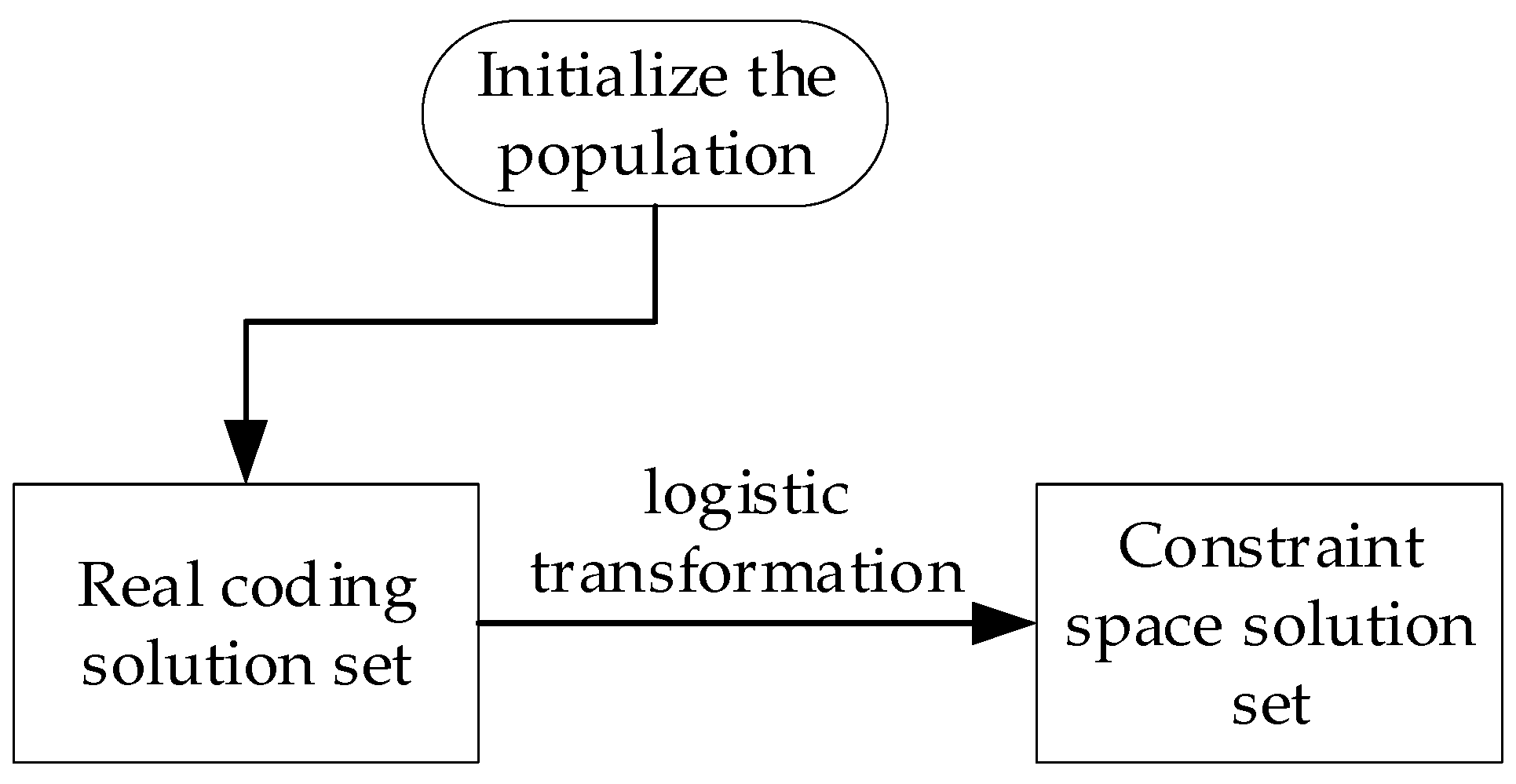

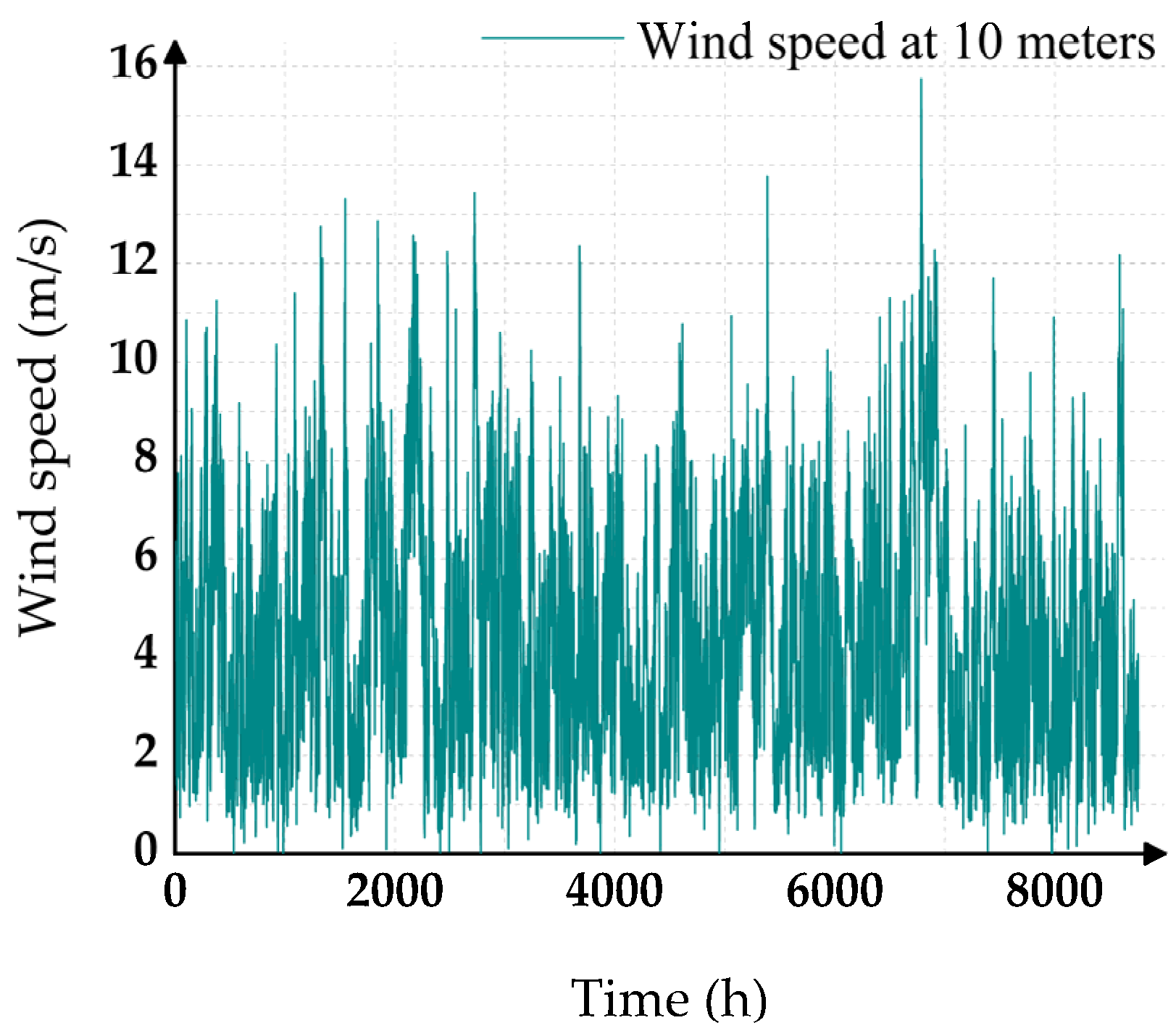

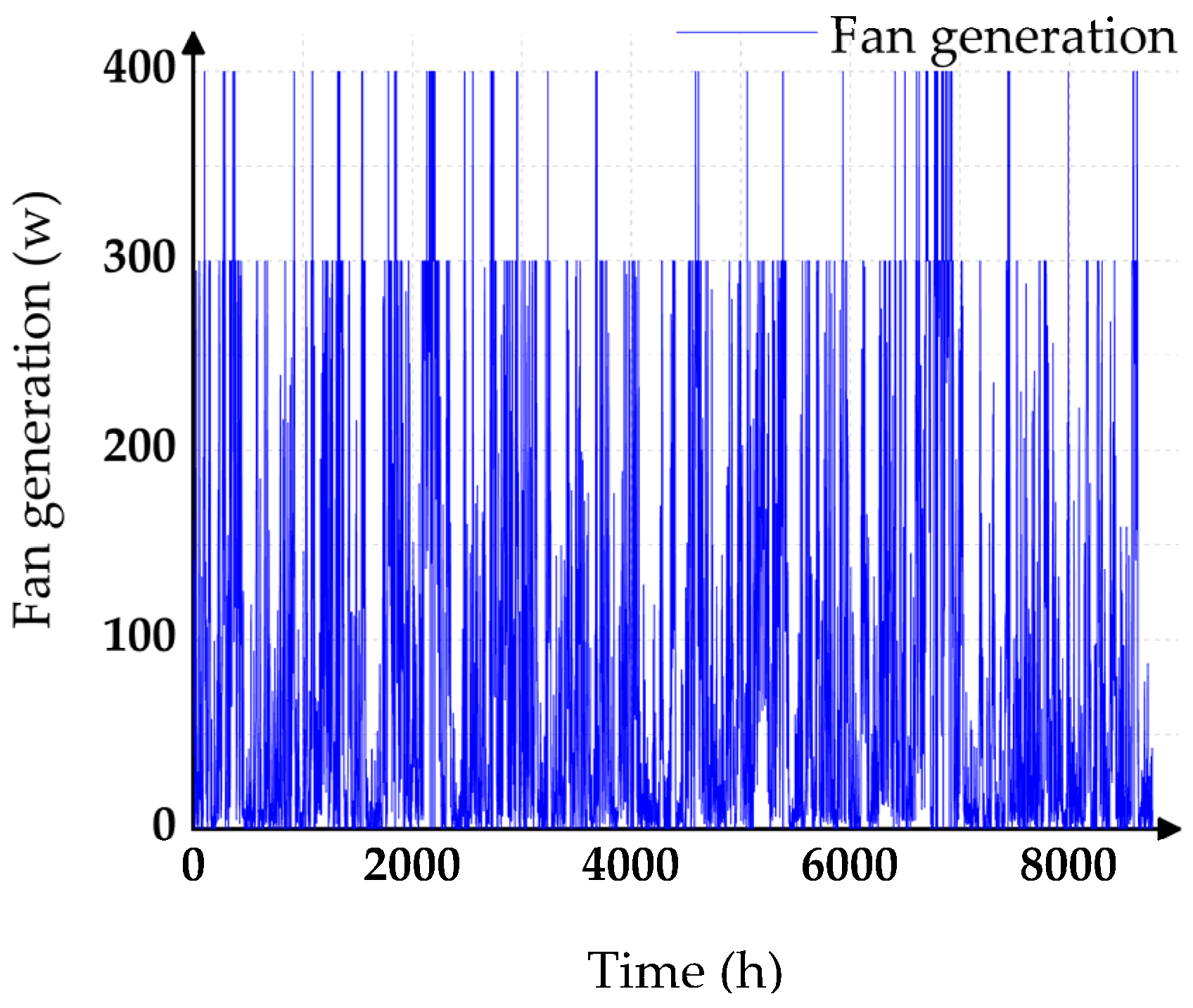
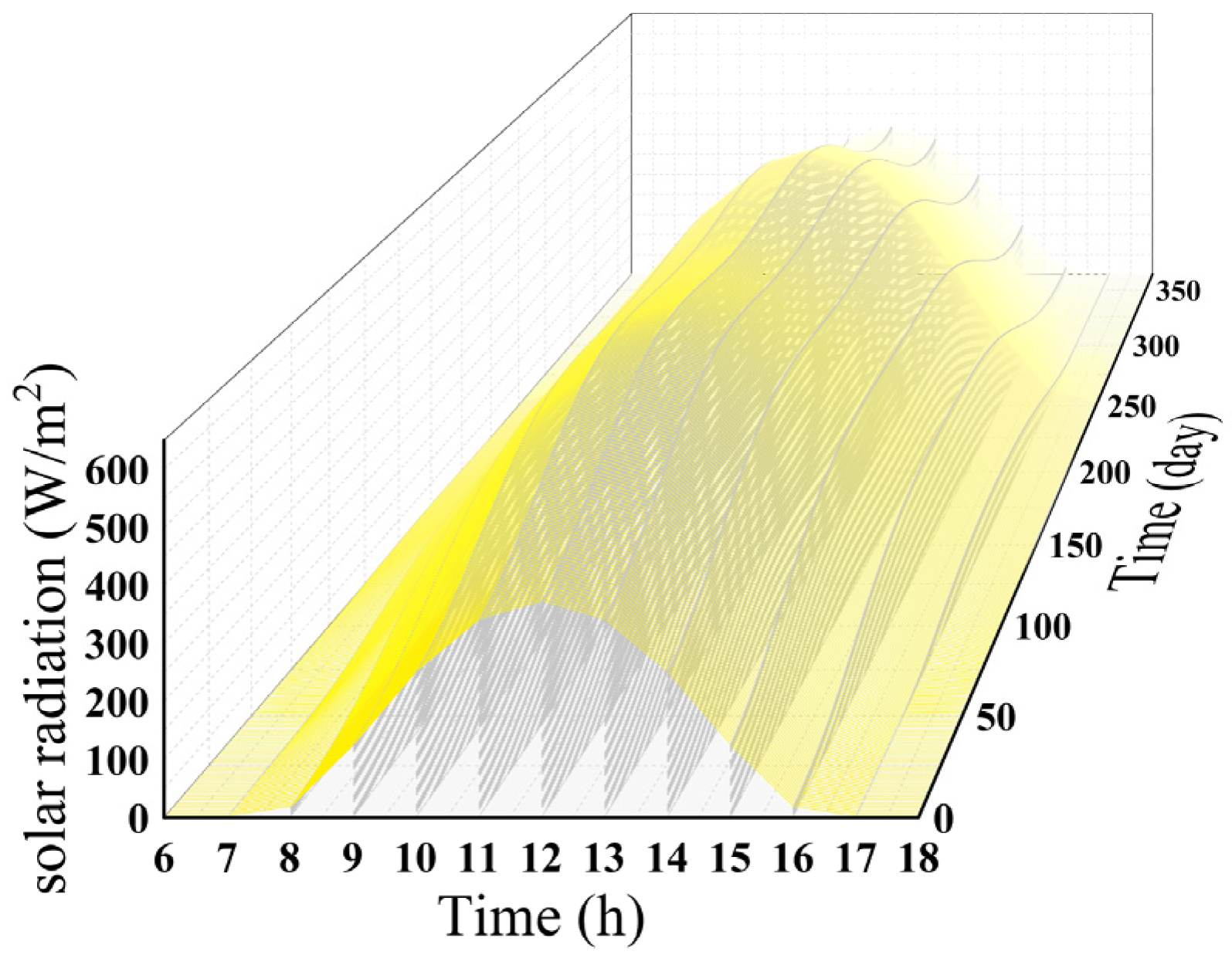
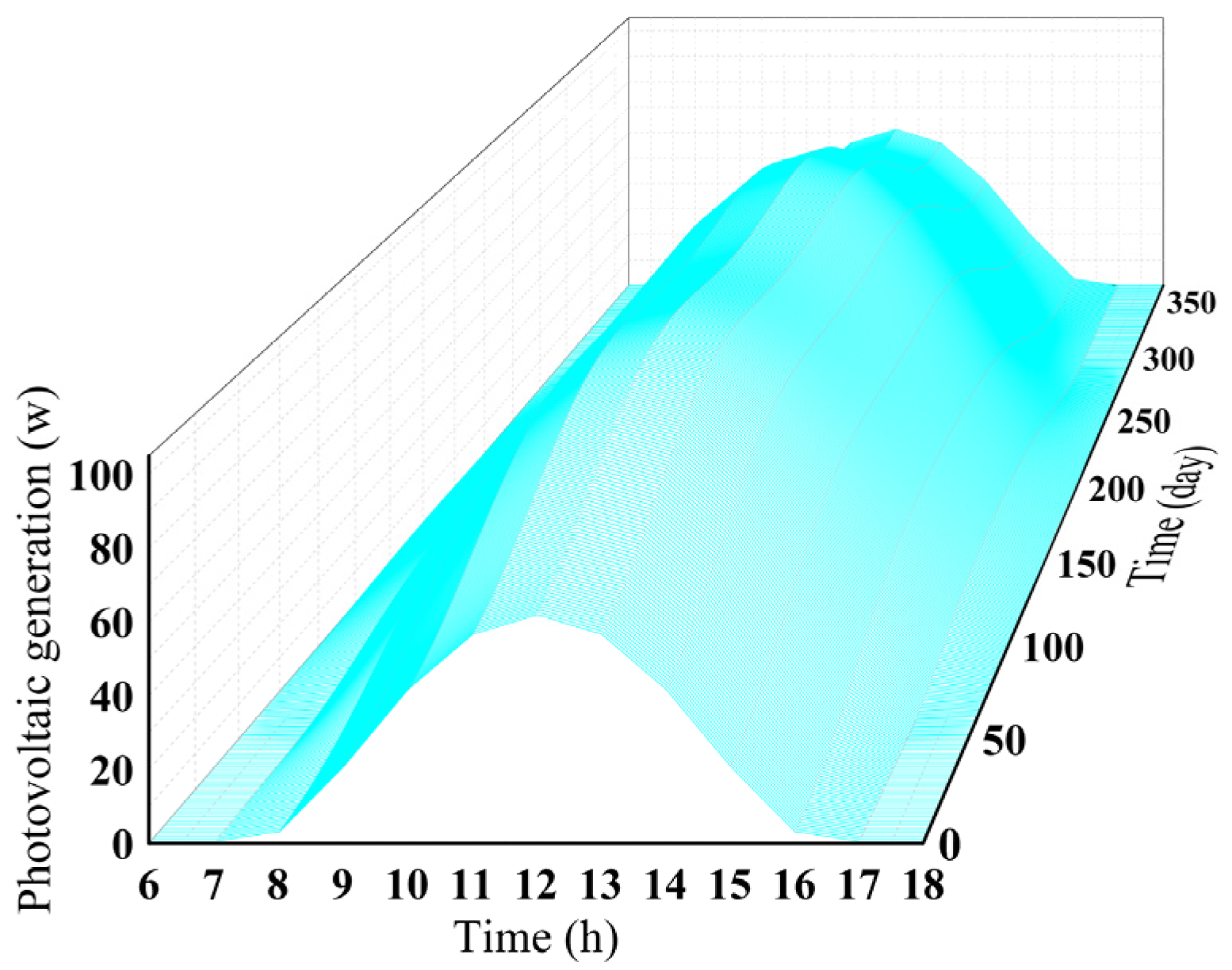
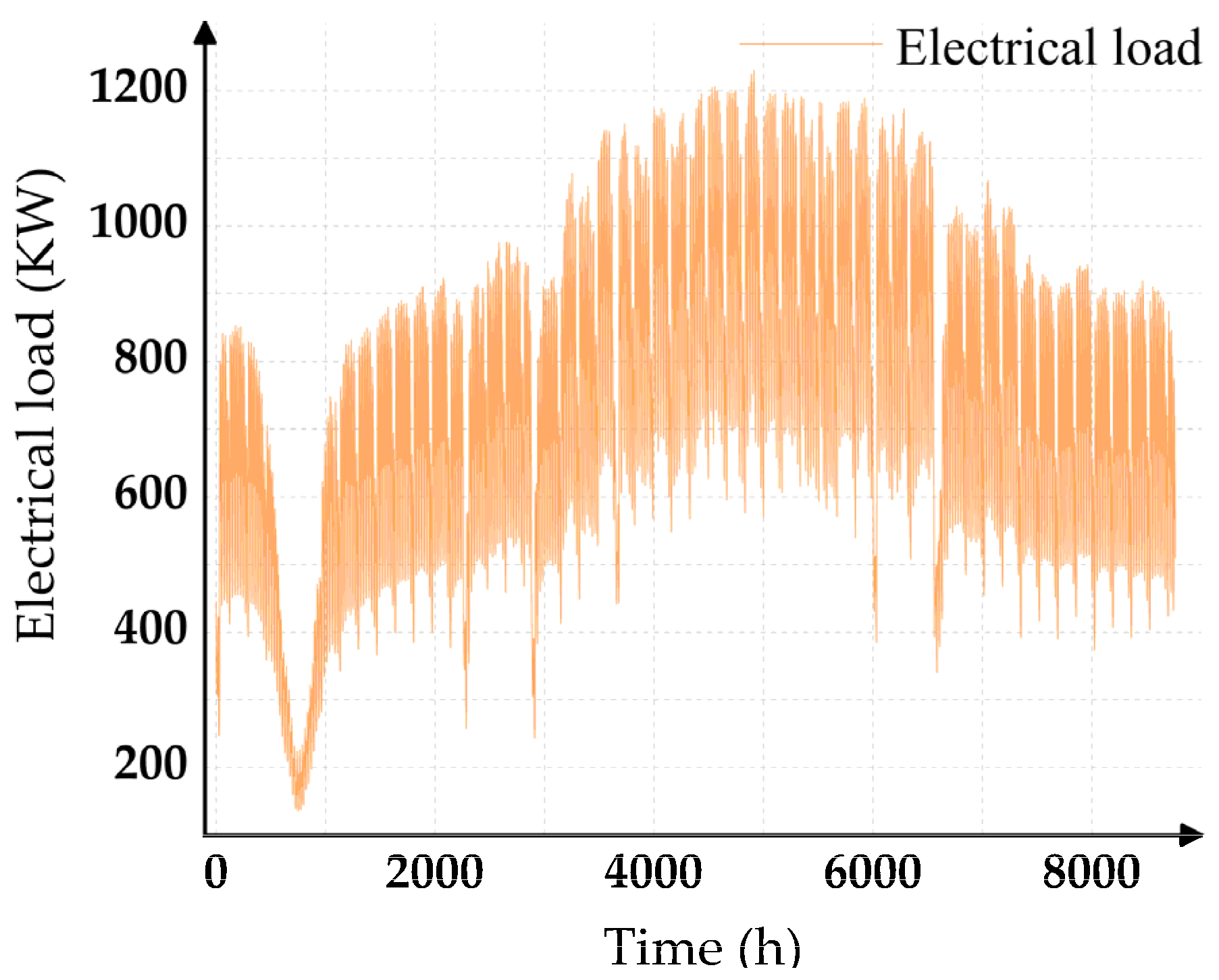
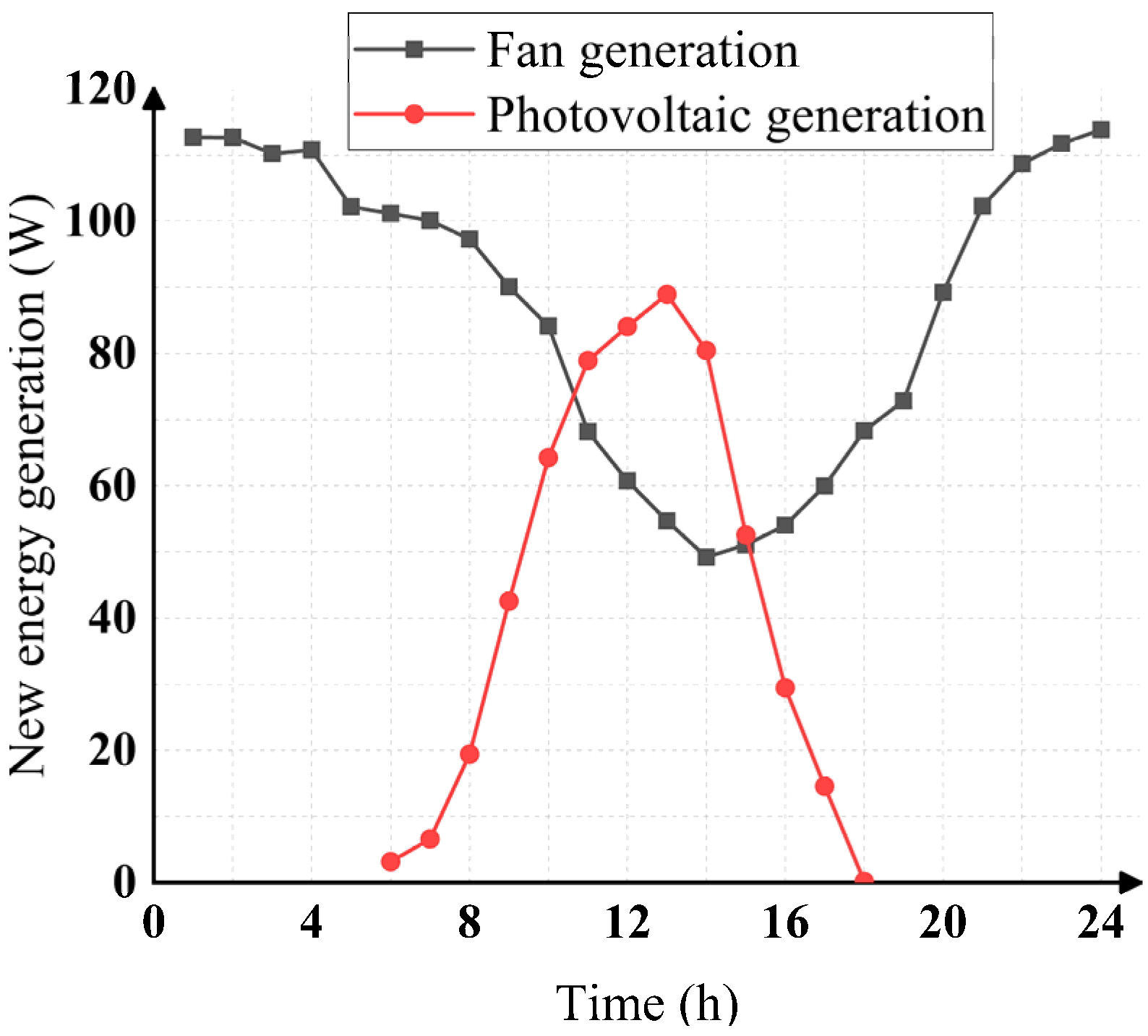
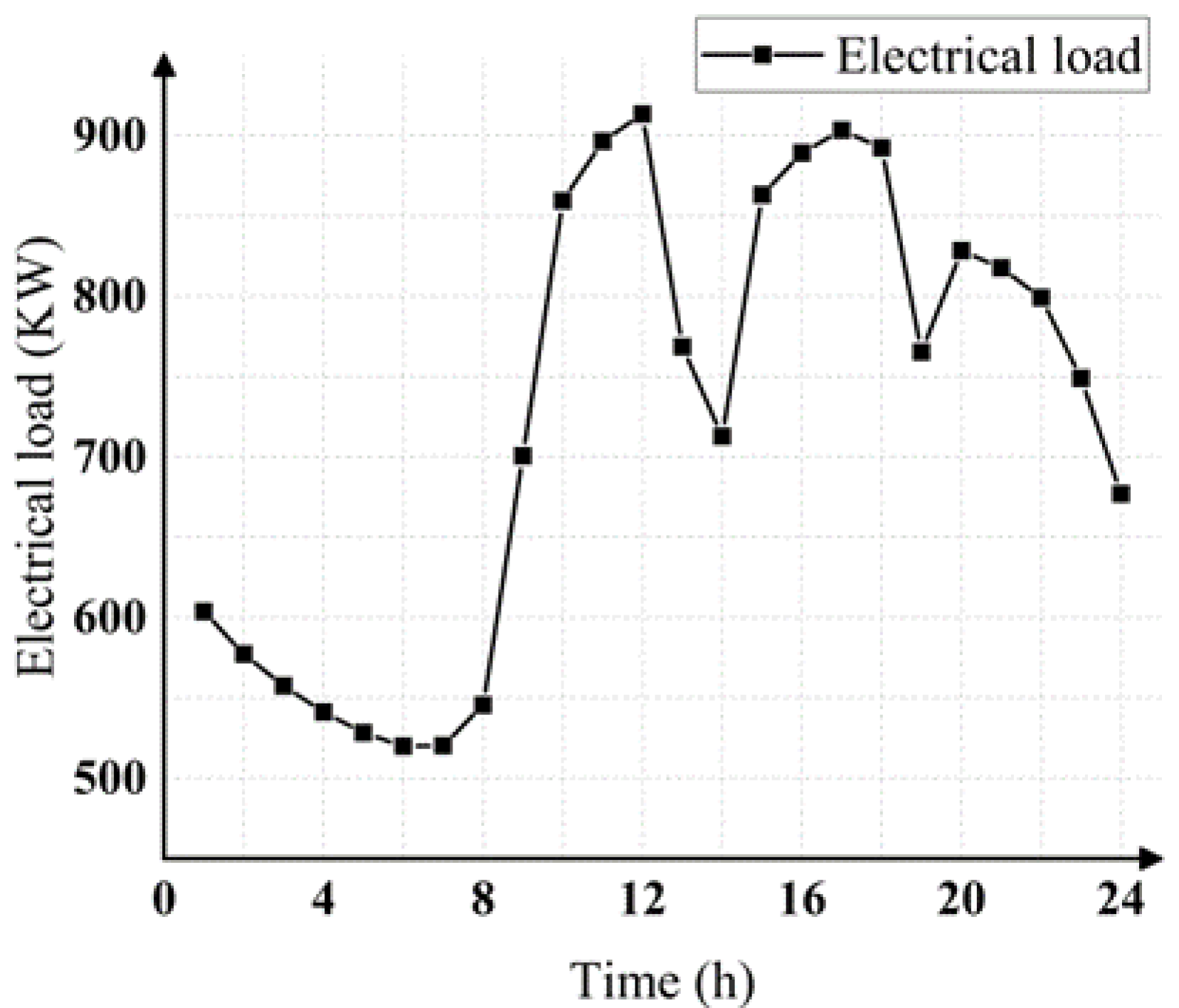
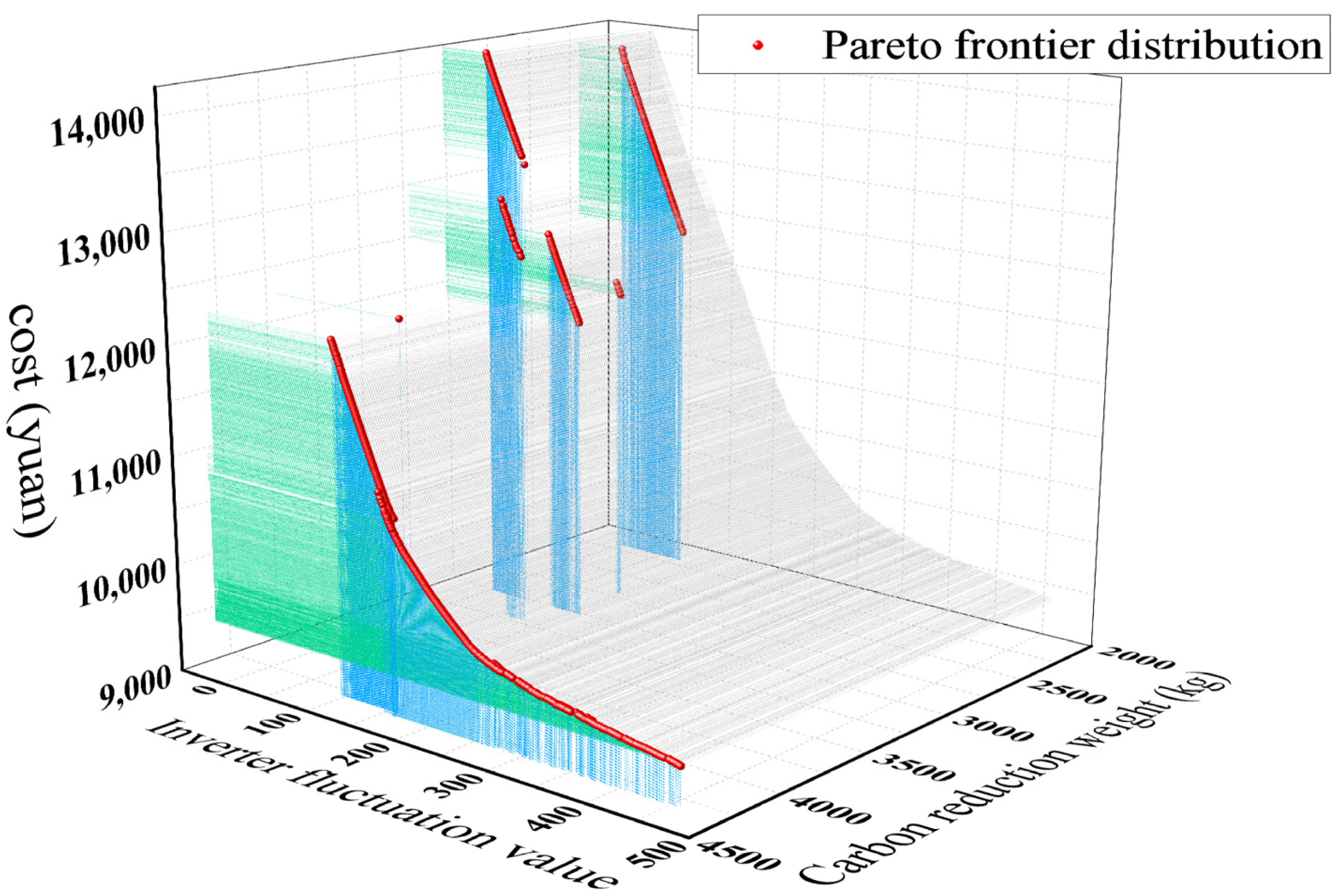
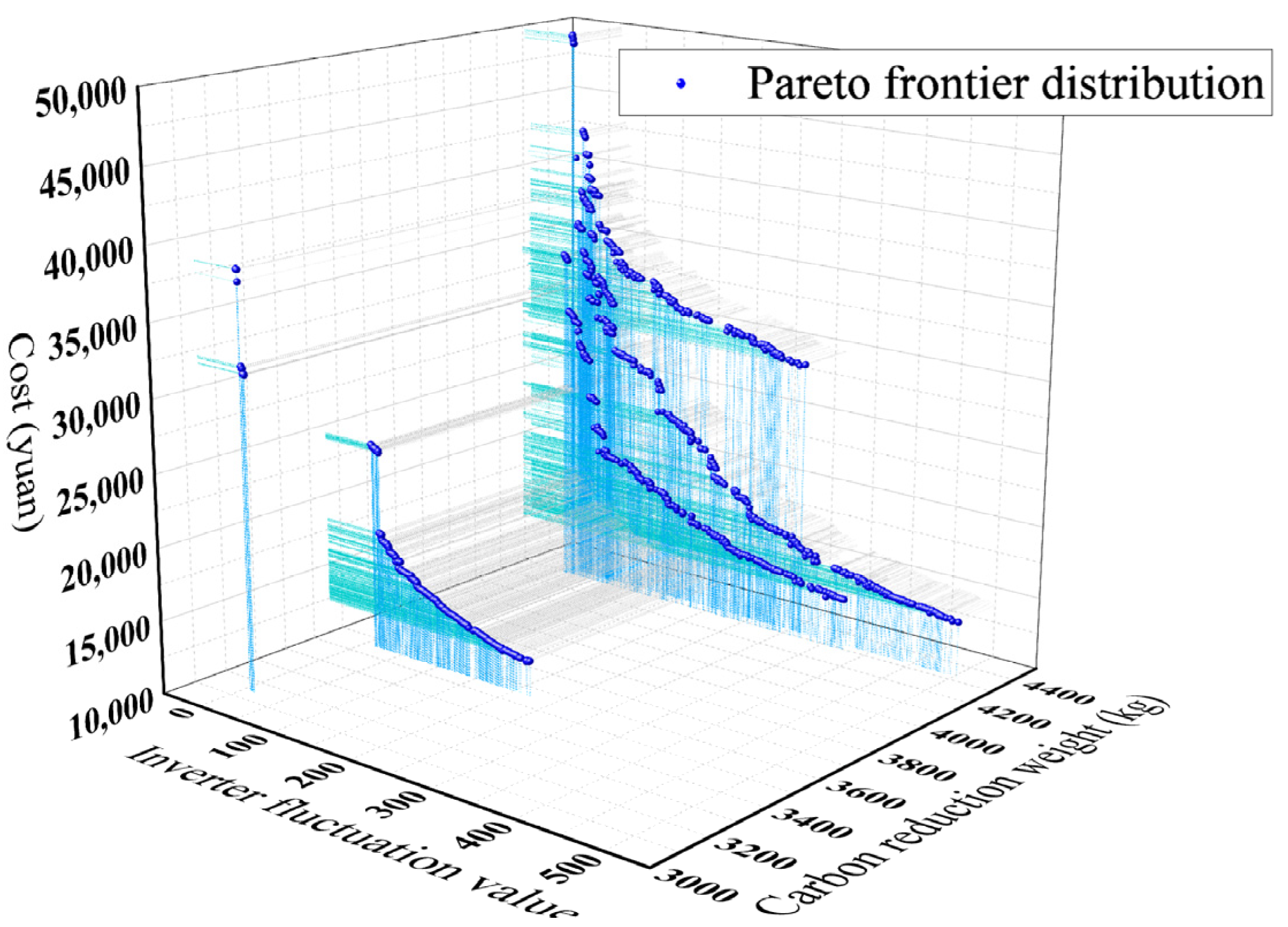
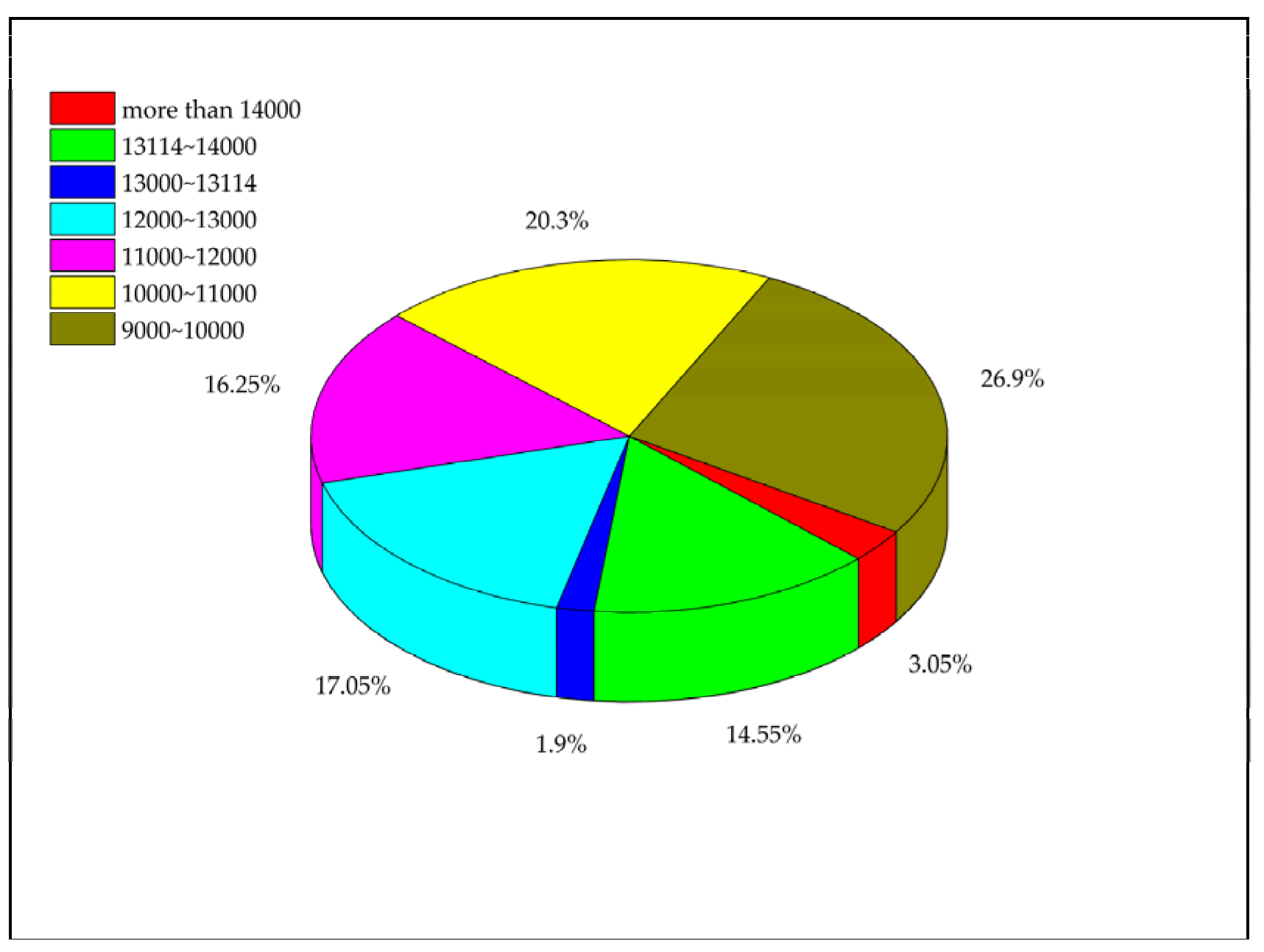
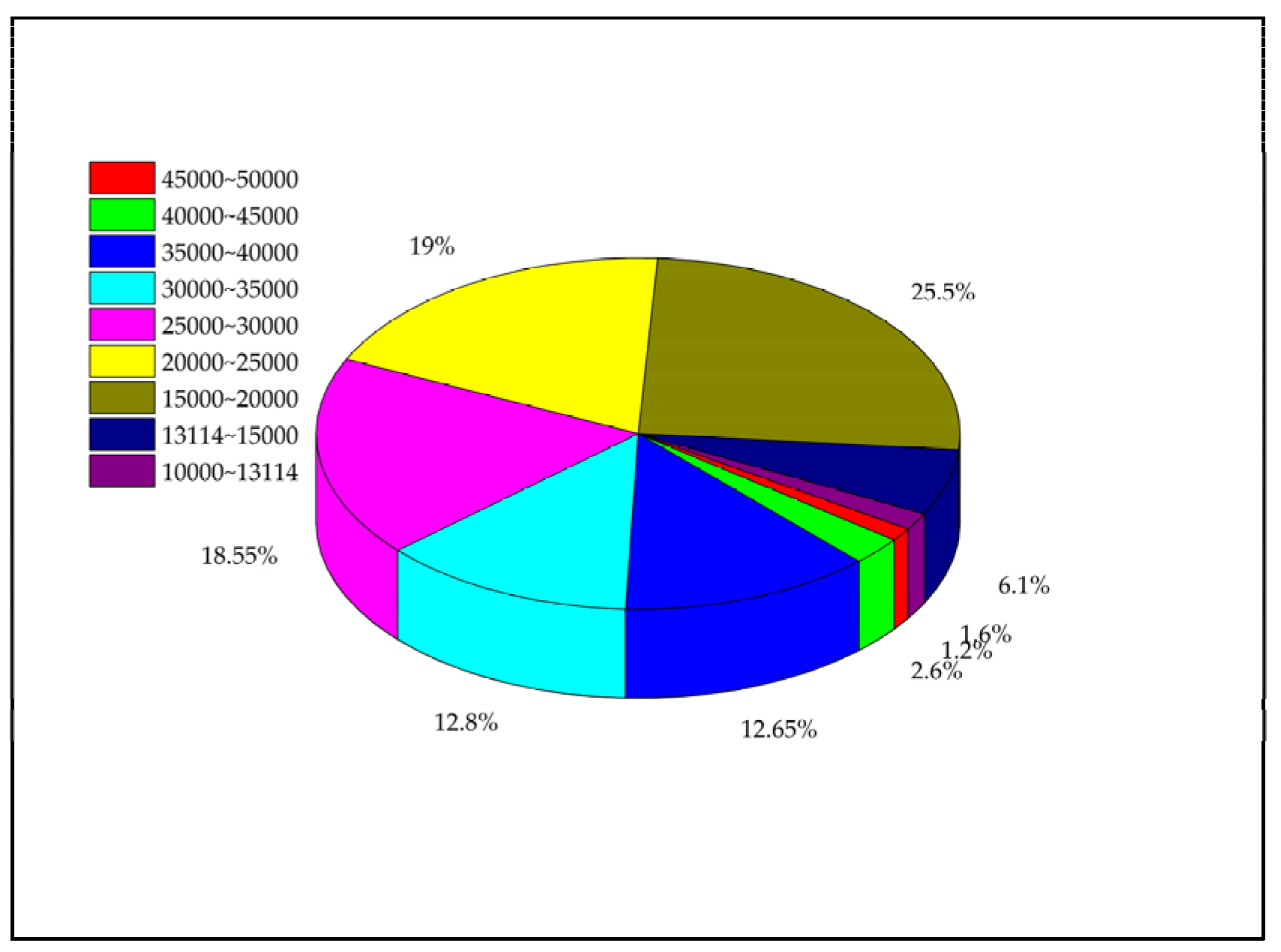
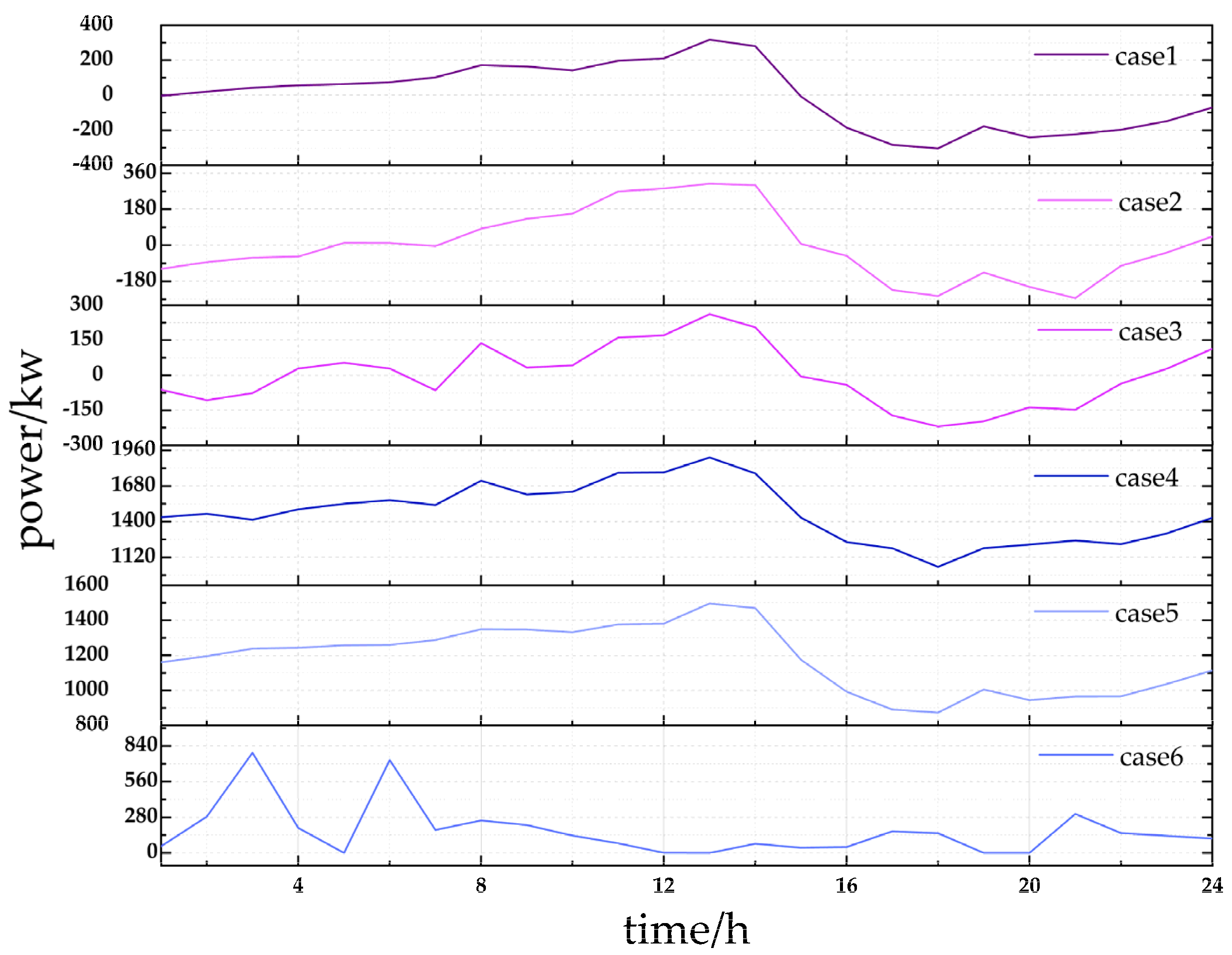
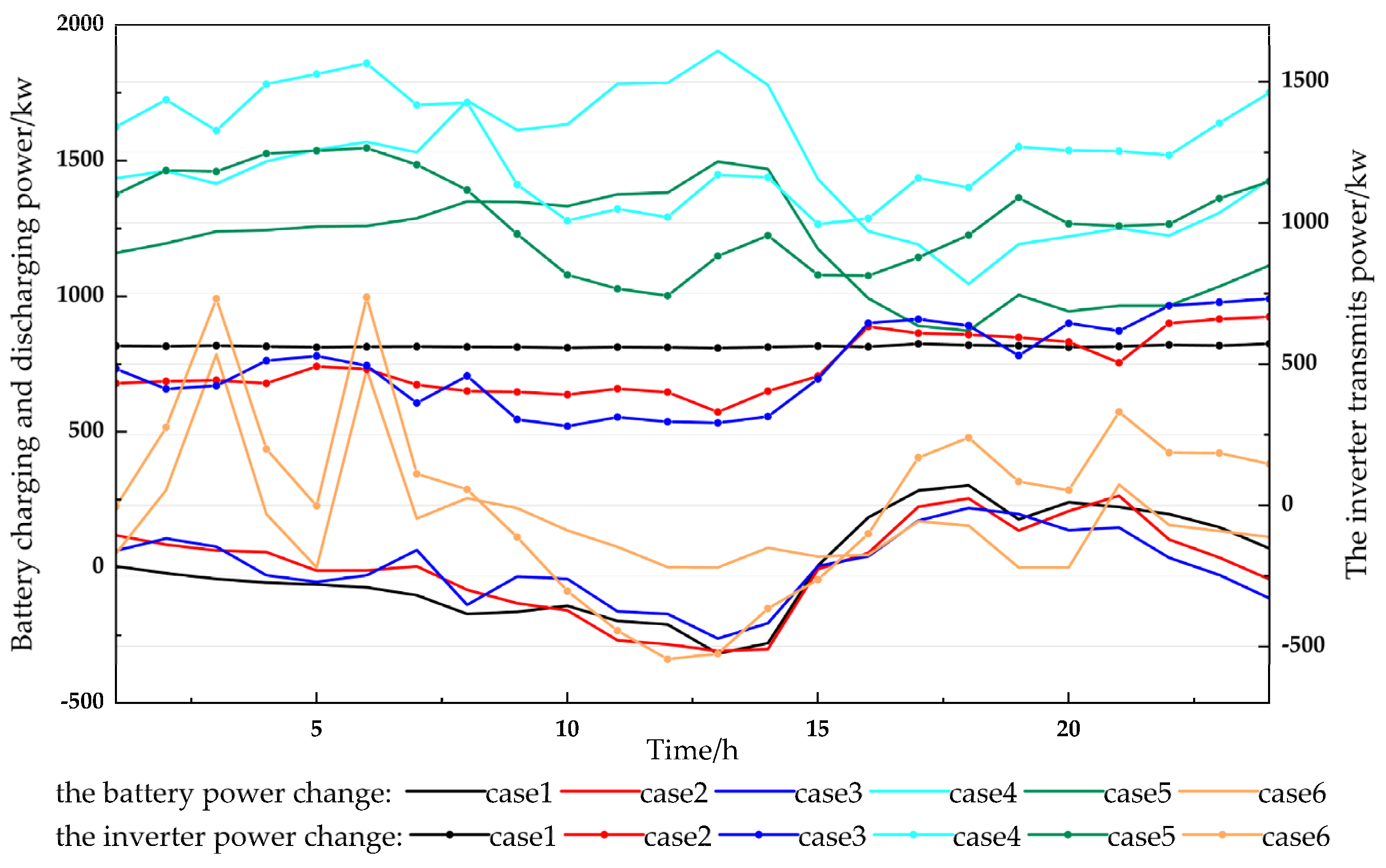

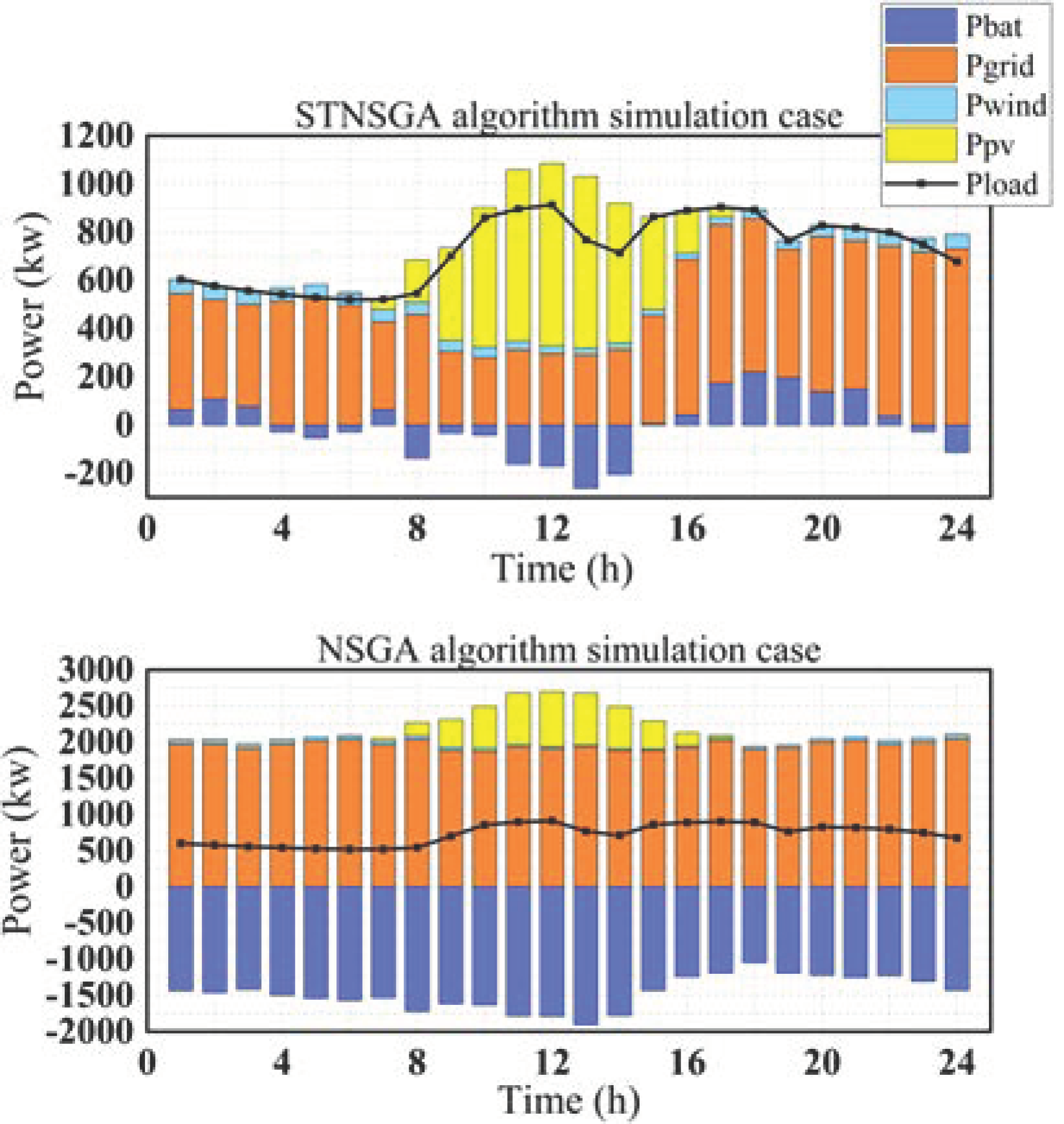
| Fan Model | Vci | Vr | Vmax | Vco | Pfr | Pfm | hfan | Dfan | Cp | T |
|---|---|---|---|---|---|---|---|---|---|---|
| FD-300 W (400 W) | 2 m/s | 10 m/s | 13 m/s | 15 m/s | 300 w | 400 w | 2 m | 1.22 m | 0.4215 | 20–40 °C |
| PV Array Model | HP-S100-12S |
|---|---|
| Pv size | 850 × 680 × 30 mm |
| NOCT | 45 °C ± 2 °C |
| Pstc | 100 W |
| αpv | −0.5% (±0.05%)/°C |
| Upv | 18.00 V |
| Ipv | 5.60 A |
| Gstc | 1000 W/m2 |
| Tpv,stc | 25 °C |
| Device Type | Cc | Co&m |
|---|---|---|
| Fan | 4500 ¥/KW | 800 ¥/KW |
| Photovoltaic | 9000 ¥/KW | 100 ¥/KW |
| Storage battery | 1800 × 4 ¥/KW | 60 ¥/KW |
| Grid-connected inverter | 250 ¥/KW | 50 ¥/KW |
| Algorithm | Case | Fan | Photovoltaic | Battery (kwh) | Inverter Capacity (kwh) | Average Daily Cost (yuan) | Inverte Fluctuation | Carbon Emission Reductions (kg) |
|---|---|---|---|---|---|---|---|---|
| STNSGA-II | 1 | 310 | 6486 | 3670.6 | 659.9 | 14,190 | 3.84 | 3014.3 |
| 2 | 471 | 9125 | 2472.8 | 793.5 | 12,058 | 101.8 | 4298 | |
| 3 | 518 | 9004 | 1630.5 | 731.5 | 10,993 | 150.77 | 4328.8 | |
| NSGA-II | 4 | 518 | 9004 | 1401.6 | 761.5 | 36,030 | 55.69 | 4328.4 |
| 5 | 359 | 6620 | 1404.1 | 369.2 | 32,062 | 9.7 | 3146.5 | |
| 6 | 465 | 9141 | 2323.6 | 993.7 | 13,976 | 334.33 | 4294.4 |
Disclaimer/Publisher’s Note: The statements, opinions and data contained in all publications are solely those of the individual author(s) and contributor(s) and not of MDPI and/or the editor(s). MDPI and/or the editor(s) disclaim responsibility for any injury to people or property resulting from any ideas, methods, instructions or products referred to in the content. |
© 2023 by the authors. Licensee MDPI, Basel, Switzerland. This article is an open access article distributed under the terms and conditions of the Creative Commons Attribution (CC BY) license (https://creativecommons.org/licenses/by/4.0/).
Share and Cite
Li, S.; Zhou, H.; Xu, G. Research on Optimal Configuration of Landscape Storage in Public Buildings Based on Improved NSGA-II. Sustainability 2023, 15, 1460. https://doi.org/10.3390/su15021460
Li S, Zhou H, Xu G. Research on Optimal Configuration of Landscape Storage in Public Buildings Based on Improved NSGA-II. Sustainability. 2023; 15(2):1460. https://doi.org/10.3390/su15021460
Chicago/Turabian StyleLi, Shibo, Hu Zhou, and Genzhu Xu. 2023. "Research on Optimal Configuration of Landscape Storage in Public Buildings Based on Improved NSGA-II" Sustainability 15, no. 2: 1460. https://doi.org/10.3390/su15021460
APA StyleLi, S., Zhou, H., & Xu, G. (2023). Research on Optimal Configuration of Landscape Storage in Public Buildings Based on Improved NSGA-II. Sustainability, 15(2), 1460. https://doi.org/10.3390/su15021460





